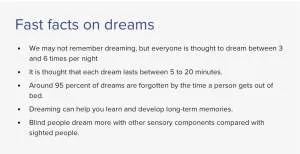(Medical News Today) Dreams are stories and images that our minds create while we sleep. They can be entertaining, fun, romantic, disturbing, frightening, and sometimes bizarre.
They are an enduring source of mystery for scientists and psychological doctors. Why do dreams occur? What causes them? Can we control them? What do they mean?
This article will explore the current theories, causes, and applications of dreaming.

Causes

There are several theories about why we dream. Are dreams merely part of the sleep cycle, or do they serve some other purpose?
Possible explanations include:
- representing unconscious desires and wishes
- interpreting random signals from the brain and body during sleep
- consolidating and processing information gathered during the day
- working as a form of psychotherapy
From evidence and new research methodologies, researchers have speculated that dreaming serves the following functions:
- offline memory reprocessing, in which the brain consolidates learning and memory tasks and supports and recordsTrusted Source waking consciousness
- preparing for possible future threatsTrusted Source
- cognitive simulation of real life experiences, as dreaming is a subsystem of the waking default network, the part of the mind active during daydreaming
- helping develop cognitiveTrusted Source capabilities
- reflecting unconscious mental functionTrusted Source in a psychoanalytic way
- a unique state of consciousness that incorporates experienceTrusted Source of the present, processing of the past, and preparation for the future
- a psychological space where overwhelming, contradictory, or highly complex notions can be brought togetherTrusted Source by the dreaming ego, notions that would be unsettling while awake, serving the need for psychological balance and equilibrium
Much that remains unknown about dreams. They are by nature difficult to study in a laboratory, but technology and new research techniques may help improve our understanding of dreams.
Phases of sleep

There are five phases of sleep in a sleep cycle:
Stage 1: Light sleep, slow eye movement, and reduced muscle activity. This stage forms 4 to 5 percent of total sleep.
Stage 2: Eye movement stops and brain waves become slower, with occasional bursts of rapid waves called sleep spindles. This stage forms 45 to 55 percent of total sleep.
Stage 3: Extremely slow brain waves called delta waves begin to appear, interspersed with smaller, faster waves. This accounts for 4 to 6 percent of total sleep.
Stage 4: The brain produces delta waves almost exclusively. It is difficult to wake someone during stages 3 and 4, which together are called “deep sleep.” There is no eye movement or muscle activity. People awakened while in deep sleep do not adjust immediately and often feel disoriented for several minutes after waking up. This forms 12 to 15 percent of total sleep.
Stage 5: This stage is known as rapid eye movement (REM). Breathing becomes more rapid, irregular, and shallow, eyes jerk rapidly in various directions, and limb muscles become temporarily paralyzed. Heart rate increases, blood pressure rises, and males develop penile erections. When people awaken during REM sleep, they often describe bizarre and illogical tales. These are dreams. This stage accounts for 20 to 25 percent of total sleep time.
Neuroscience offers explanations linked to the rapid eye movementTrusted Source (REM) phase of sleep as a likely candidate for the cause of dreaming.
What are dreams?
Dreams are a universal human experience that can be described as a state of consciousness characterized by sensory, cognitive and emotional occurrences during sleep.
The dreamer has reducedTrusted Source control over the content, visual images and activation of the memory.
There is no cognitive stateTrusted Source that has been as extensively studied and yet as frequently misunderstood as dreaming.
There are significant differences between the neuroscientific and psychoanalytic approaches to dream analysis.
Neuroscientists are interested inTrusted Source the structures involved in dream production, dream organization, and narratability. However, psychoanalysis concentrates on the meaning of dreams and placing them in the context of relationships in the history of the dreamer.
Reports of dreams tend to beTrusted Source full of emotional and vivid experiences that contain themes, concerns, dream figures, and objects that correspond closely to waking life.
These elements create a novel “reality” out of seemingly nothing, producing an experienceTrusted Sourcewith a lifelike timeframe and connections.






